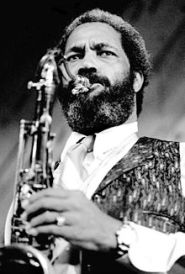
By Devon Wendell
There’s nothing quite like a gritty Chicago tenor saxophone battle, especially during the post war hard-bop era. By the mid ‘50s, Players like Johnny Griffin, Gene Ammons, Von Freeman, and John Neely were blowing at each other with this insatiable hypo-manic bop that would make your head spin.
 What these men played could be very sweet and seductive one moment and then turn around and cut you like an axe the next. Clifford Jordan was a part of this school of rough edged Chicago tenor players before moving to New York City in 1957.
What these men played could be very sweet and seductive one moment and then turn around and cut you like an axe the next. Clifford Jordan was a part of this school of rough edged Chicago tenor players before moving to New York City in 1957.
Both Ammons and Griffin would record tenor stand-offs with players from outside of Chicago like Hank Mobley, John Coltrane, Sonny Stitt, and Dexter Gordon.
The “Chi-Town” tenor cutting matches were like musical snapshots of the harshness of the city from which they blossomed. With that being said, it’s not surprising that Clifford Jordan’s very first session date as a band leader for Blue Note Records in 1957 — Cliff Jordan & John Gilmore: Blowing In From Chicago — would be a take-no-prisoners duel with another of the city’s fearlessly ambitious tenor-man — the incomparable and illusive John Gilmore.

Gilmore’s relentless dedication to Sun Ra’s “subversive” orbit from 1953 through Ra’s death in 1993 made him a mysterious figure to the bop purists and jazz press. However, throughout the ’60s, Gilmore would occasionally venture from Ra’s Arkestra to make some exceptional records with artists like Freddie Hubbard, Paul Bley, McCoy Tyner, Art Blakey, Andrew Hill, and Pete La Roca. Gilmore strongly viewed Sun Ra’s approach to music as being the harmonic continuation of the bebop started by Charlie Parker, Dizzy Gillespie, and Thelonious Monk.
His first project away from Ra was this tenor blowing session with Clifford Jordan on March 13, 1957, featuring Horace Silver on piano, Curly Russell on bass, and Art Blakey on drums. This resulted in the phenomenal Blowing In From Chicago album.
The first track on the album is “Status Quo” which has the same changes to it as “There Will Never Be Another You.” The harmonies created between Jordan and Gilmore on the song’s head are beautiful in that traditional bebop form. After that, the competition begins and rises to a near boiling point.

When I hear Jordan and Gilmore swapping solos, I envision two poisonous vipers coiled in a bloody fight to the death. That’s how hard burning every tenor line is played on this record. And it gets more aggressive throughout the album. On the Latin-tinged blues number “Bo-Till”, Gilmore’s harmonically complex, angular tenor lines give Jordan a run for his money. There’s also an agility and adventurousness to Gilmore’s style whereas Jordan plays more traditionally, at times sounding like Dexter Gordon but without Gordon’s rich vibrato. Both men are swinging beyond belief here.
“Blue Lights” and “Evil Eye” are sly, mid-tempo minor key blues-bop numbers that allow wider solo space for Jordan, Gilmore, and the entire band. Gilmore takes the first solo. It’s immediately apparent how influential Gilmore was on John Coltrane, especially during the late ‘50s and early ‘60s. Coltrane even took lessons from Gilmore during this period in New York and was forever transformed. Gilmore plays mostly in the altissimo register of his horn while Jordan plays in the middle. Despite the competitive feel of these pieces, the two men complement each other’s styles beautifully.
The version of Charlie Parker’s “Billie’s Bounce” (played at twice the tempo of the original) is a true head cutter. That one of a kind Blakey beat is unabashedly hard. Russell and Silver are right there with him, pushing it even harder and adding texture. These men had already performed and recorded many times together up until this time and knew each other’s styles instinctively. Blakey, Silver, and Russell were featured together on the infamous Art Blakey: A Night At Birdland Vol.1 and Vol.2 albums in 1954 on Blue Note with Clifford Brown and Lou Donaldson. Their presence here is very similar, which is high praise.
Gilmore plays Jordan’s style back at him when it’s his turn to cook on this Bird classic, which is incredible. This is a more conservative setting for Gilmore, but he demonstrates his diversity and his masterful knowledge of the bebop language. Gilmore even quotes a few of Bird’s alto phrases from “Cool Blues” and “Klaunstance” while Horace Silver quotes Thelonious Monk’s “52nd Street Theme” and “Rhythm-A-Ning.”
Horace Silver’s “Everywhere” and “Let It Stand” have a jubilance to them that reminds me of the tenor matches between Al Cohn and Zoot Sims. The mood is slightly cooler than on the previous tracks but equally as powerful. Jordan and Gilmore are laying back and grooving with love and soul. Blakey’s clean swinging hi-hat rides along with Russell’s steady walking bass lines, keeping everything perfect. Horace Silver’s lively piano solos are beautifully syncopated and harmonically brilliant.
Cliff Jordan & John Gilmore: Blowing In From Chicago is the perfect example of the power and bliss of a true late ‘50s Chicago style tenor saxophone battle. And it is a glimpse into the future direction of the instrument by two masterfully adventurous stylists of that era. It’s hard to find anything that swings as hard as this.
* * * * * * * *
To read more posts, reviews and columns by Devon Wendell click HERE.